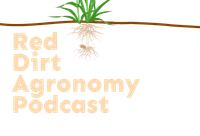Welcome to
RED DIRT AGRONOMY
NEW EPISODES • ABOUT EVERY OTHER WEEK
The latest episode of the
Red Dirt Agronomy Podcast
Episode 425
Wheat Pasture, Feedlots, and the Future Herd
Resources
-
Derrell Peel, Ph.D.
-
Listen to Episode 425
Two SCIENTISTS AND DAVE
These guys all grew up in Oklahoma and understand what it's like to work hard to grow crops in the red dirt.
Dave talks with them about their crop research, ideas that may help ag producers get the most out of their land, and what it's like to live in rural America.
The Top 5 Oklahoma Crops That Drive the State's Economy
Oklahoma's expansive and varied landscapes make it a powerhouse in American agriculture.
With over 77,000 farms spread across the state, agriculture remains a foundational pillar of Oklahoma's economy.
Among the many agricultural products, certain crops stand out for their significant economic contribution, resilience, and versatility.
Understanding these top crops offers insight into the state's agricultural strength and future.
Overview of Oklahoma Agriculture
Oklahoma benefits from a mix of prairie, plains, and fertile river valleys, creating ideal conditions for a wide range of crops.
From the western panhandle to the eastern forests, Oklahoma's climate and geography support both row crops and specialty farming.
Agriculture contributes billions to the state economy annually, with crops playing a central role alongside livestock and poultry.
Importance of Crops to Oklahoma's Economy
Crops are not only essential for food and feed but also fuel rural economies, support agribusinesses, and provide employment.
They serve as a key export for the state and form the backbone of many communities.
Technological advancements and sustainable farming practices continue to boost productivity and efficiency, reinforcing the importance of crop agriculture to Oklahoma's economic well-being.
1. Wheat
What is Wheat?
Wheat, particularly hard red winter wheat, is a staple crop in Oklahoma, deeply embedded in its agricultural heritage.
It thrives in the central and western regions of the state, where the semi-arid climate and well-drained soils suit its growth cycle.
Economic Impact of Wheat Production
Wheat is Oklahoma's top crop by acreage and a major export commodity. The state consistently ranks among the top wheat producers in the nation. Wheat farming supports grain elevators, milling industries, and transportation sectors, making it a linchpin in the state's rural economy.
2. Corn
Corn Varieties Grown in Oklahoma
Farmers in Oklahoma grow both field corn and sweet corn, with field corn being the more common variety. It is used for livestock feed, ethanol production, and food products.
Uses and Benefits of Corn Crops
Corn is crucial for both animal agriculture and renewable energy sectors. Its versatility in uses and ability to adapt to varying climates make it a reliable cash crop. Eastern and northern Oklahoma see the most corn production due to better rainfall and fertile soils.
3. Soybeans
Growing Conditions for Soybeans
Soybeans flourish in Oklahoma's eastern and central regions.
They require warm temperatures and moderate rainfall, aligning well with the state's summer climate.
Role of Soybeans in Oklahoma Agriculture
Soybeans are essential for livestock feed, oil production, and as a protein source in global markets.
Their nitrogen-fixing capabilities also improve soil health, making them a popular rotational crop among Oklahoma farmers.
4. Sorghum
Key Characteristics of Sorghum
Sorghum is a drought-tolerant crop that grows well in the drier regions of western Oklahoma.
It can be used for grain, forage, and even biofuel.
Sorghum’s Contribution to Local Economy
Sorghum provides farmers with a resilient alternative in years with less precipitation.
Its low input requirements and growing demand for gluten-free products enhance its economic value in Oklahoma agriculture.
5. Cotton
Cotton Production Practices in Oklahoma
Cotton is primarily grown in southwestern Oklahoma, where the climate favors its long growing season. Farmers use modern irrigation, pest management, and harvesting technologies to maximize yields.
Economic Benefits of Cotton Farming
Cotton contributes significantly through textile manufacturing and export. It also supports ancillary industries such as ginning, seed production, and transportation, helping sustain local economies.
What Oklahoma Agriculture Means
From wheat fields to cotton rows, Oklahoma's top crops are a testament to the state's agricultural diversity and strength.
These crops drive local economies, support global markets, and contribute to the state’s sustainability goals.
Future of Agriculture in Oklahoma
As technology advances and environmental challenges evolve, Oklahoma's agricultural community continues to adapt. With ongoing research, education through Extension services, and investment in sustainable practices, the future of Oklahoma agriculture looks both promising and resilient.'s expansive and varied landscapes make it a powerhouse in American agriculture.
With over 77,000 farms spread across the state, agriculture remains a foundational pillar of Oklahoma's economy.
Among the many agricultural products, certain crops stand out for their significant economic contribution, resilience, and versatility.
Understanding these top crops offers insight into the state's agricultural strength and future.
Overview of Oklahoma Agriculture
Oklahoma benefits from a mix of prairie, plains, and fertile river valleys, creating ideal conditions for a wide range of crops.
From the western panhandle to the eastern forests, Oklahoma's climate and geography support both row crops and specialty farming.
Agriculture contributes billions to the state economy annually, with crops playing a central role alongside livestock and poultry.
Importance of Crops to Oklahoma's Economy
Crops are not only essential for food and feed but also fuel rural economies, support agribusinesses, and provide employment.
They serve as a key export for the state and form the backbone of many communities.
Technological advancements and sustainable farming practices continue to boost productivity and efficiency, reinforcing the importance of crop agriculture to Oklahoma's economic well-being.







